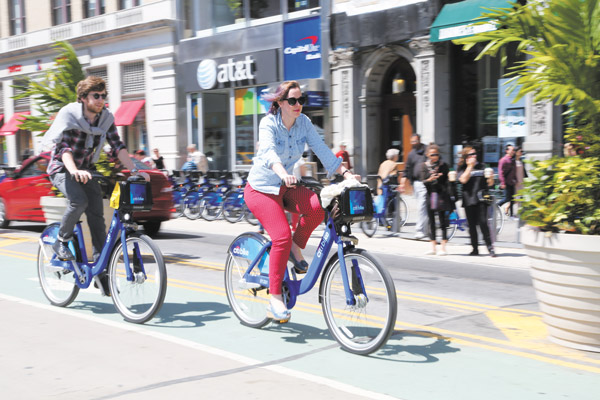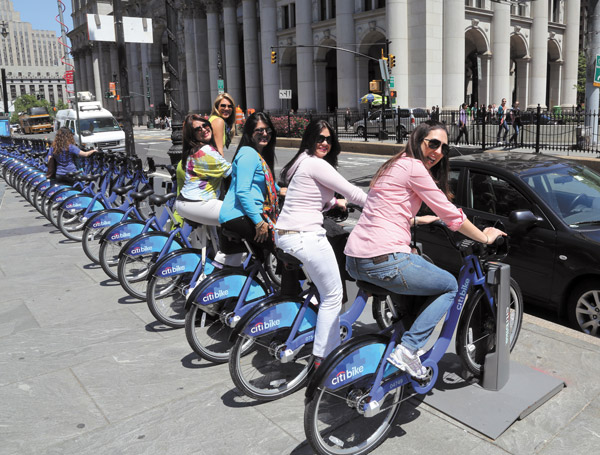
Citi Bike riders on the first day, May 27.
BY LINCOLN ANDERSON | One of the frequently heard fears about the Citi Bike program is that it will just mean thousands of more cyclists zooming around on the streets dangerously out of control.
I got a chance to test-ride one of the new bike-share cycles just before the program started, and “zooming” wasn’t exactly the first word that sprang to mind. In fact, these bikes are pretty heavy — 45 pounds — and, well, definitely on the slow side.
I was among a group of reporters who got to take the bikes for a spin at the Brooklyn Navy Yard last Friday. First, Dani Simons, director of marketing and external affairs for NYC Bike Share, the operator of Citi Bike, explained the basics about the bikes.
Clearly printed on the top of each bike’s handlebar stem, she noted, are the instructions — ones that many Downtowners say bicyclists disobey — “Yield to pedestrians”; “Stay off the sidewalk”; “Obey traffic lights”; “Ride with traffic.”
“I call these the four cardinal rules of biking in New York City,” Simons noted.
If you purchased a $95 annual membership, you should have received a key — a small, blue, plastic stick — that you can insert into any docking station to release a bike.
Annual members can ride for 45 minutes, after which they have to park it at another dock, or face additional charges.
So-called “casual members,” people who purchase a daily ($9.95) or weekly ($25) bike-share pass, won’t get a key, but will swipe a credit card on a bike-share kiosk. They’ll receive a five-digit code that they’ll use to unlock a bike, which they can ride for a shorter period — 30 minutes — before re-docking it, and can then take additional 30-minute rides.
People with yearly memberships started riding May 27, and the daily and weekly program will kick off June 2.
If cyclists don’t return the bikes within the allotted time, charges kick in: $2.50 for the first half hour, $6.50 for the second half hour and $9 for each additional half hour.
If you ride to a bike dock and all its slots are full, you can get a 15-minute extension. I assumed people would just use the extra time to wait for a slot to open up, but the energetic Simons said she’d use it to bike to another nearby station.
Once the key or the code is put in, there’s a beep and a small green light displays on the dock, indicating the bike can be pulled out. A reporter for one of the city’s daily tabloids who recently test-rode one of the bikes moaned about how difficult it was to remove the bike from the dock, saying she literally had to get on her knees and yank it out with all her strength.

Tourists near City Hall gave the bike seats a try.
But there’s a right way and a wrong way to pull out a Citi Bike. As Simons explained, the wrong way is to try to pull it out by the handlebars, which doesn’t work — the bike barely budges. The right way is simply to grab hold under the seat’s back with one hand and lift the bike up a couple of inches, which is quite easy to do — “and I don’t have biceps like Michelle Obama,” Simons quipped — and then step backward. The bike slides out of the dock effortlessly.
Next, check that the tires have air and that the brakes are working properly. If there’s a problem, put the bike back and take another.
Then, adjust the seat to waist height, if it isn’t already, Simons said. Though the seat can be lowered all the way down for a very small person, Citi Bikes aren’t for kids. You must be 16 or older.
Finally, it was time to take a spin around the Navy Yard.
The bike glided along, coasting surprisingly well, if not particularly fast. The seat was wide and comfortable. The tires were fairly fat and cushy, making for smooth rolling.
One of the charges made by 99 Bank St. residents in their lawsuit against the bike-share station in front of their building is that Citi Bike riders will use their sidewalk, since Bank St. is cobblestoned. But the historic Brooklyn Navy Yard has an uneven, patchwork surface — from cobblestones to old railroad tracks half-buried in asphalt pavement — and, from the feel of the ride, I was confident that my Citi Bike could roll over these rough surfaces without problem. On the other hand, my 10-speed bike with narrow tires that I had ridden over to the Navy Yard could never handle these conditions.
Citi Bikes have three gears, with a twist-grip handlebar shifter. In first gear, in the flat Navy Yard, I found my feet spinning cartoonishly fast — I actually imagined the kooky bongos from when Fred Flintstone starts running — plus the bike didn’t really move very much. I ruled out ever using first gear again, except possibly for going up Mount Everest.
Third gear I honestly found a bit hard to pedal in; I don’t know if this was because I had just earlier zipped over the Manhattan Bridge to get to the Navy Yard — maybe blowing out my legs a bit? — but third gear felt “heavy,” and again, the bike didn’t really go very fast.
It was tricky to get into second gear with the twist shifter, requiring a very delicate touch. But once I did, I found second was still slightly too easy for me. I was pedaling a little too fast, and wanted a bit more resistance; meanwhile the bike was not making incredible forward progress. I felt, well…frustrated. Another gear between second and third — a 2½ — was where I wanted to be.
As I continued to pedal around, however, the greater realization dawned on me — in a bit of a letdown — that this bike, no matter what gear it was in, simply would never go any faster.
I returned to the docking station, where Simons demonstrated how to park it.
Grabbing the bicycle by both handlebars, she lined up a small metal triangular prow on its front with the dock, and — explaining, “Use a little force” — pushed it firmly into the slot. A green light displayed, showing the bike had locked into place.
Carlos Rivera, a Citi Bike mechanic, said the cycles are built to handle city conditions.
“Great bikes, durable,” he said. “It’s New York City — they’ve got to be tough.”
As he slowly rode off on one of the Citi Bikes — they were disassembling this Navy Yard bike station, in preparation for deploying all the bikes to the street — I noticed he was “standing” on the pedals, as in not sitting in the seat. This is what cyclists do when climbing a hill, when it’s tough to pedal. I later realized: Rivera must have been in third gear.
So maybe it’s not only me who thinks Citi Bike’s third gear is a bit hard to pedal.
I later asked Simons about the bike’s gears, wondering if maybe mine had been off.
“These are the standard gear settings,” she replied.
Oh well, even if my gears did need a tune-up, probably the answer is simple: The bikes are configured to keep anyone from being able to ride fast — which may make some readers happy.
Anaïs Digonnet, a reporter with a French Web TV station who also took a Citi Bike for a spin last week, said these ones are actually lighter than the bike-share cycles they had in Lyon a few years ago. She said it’s fine if the bikes are slow.
“Anyway, in New York you don’t want to ride too crazy,” she said. “The streets are really not made for bicycle.”
On the other hand, her native town is quite bike friendly, she said, noting, “In Lyon we have special areas for the bikes. There is a line. If the driver crosses it, there is a fine, like 90 euros.”
As for myself, I was a little underwhelmed by Citi Bike. I don’t exactly need to be in “The Fast & Furious 6” (even if Vin Diesel did grow up in Westbeth), but these wheels were a bit too slow. In the meantime, I think I’ll stick with my 10-speed 1980s road bike.

















